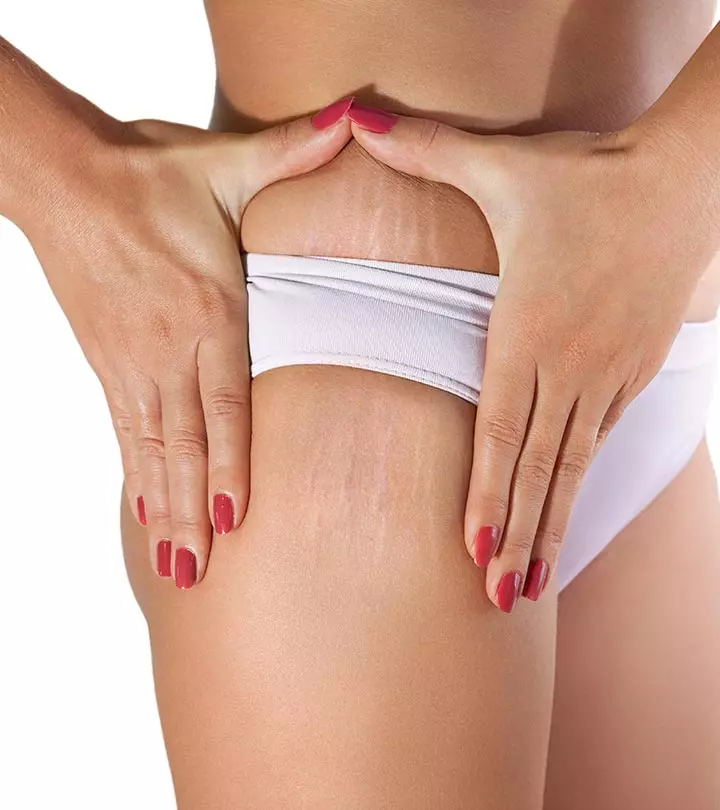Stretch Mark Tattoos: 5 Essential Things To Consider
There is more to know before you conceal your stretch marks with tattoos.

Image: Shutterstock
Many people fight the never-ending battle against stretch marks throughout their lifetimes. A huge number of people regard stretch marks to be an aesthetic issue, and they are always looking for ways to moderately or completely cover or hide them. People use everything from invasive techniques to a myriad of beauty products to fade the marks and improve their self-esteem. Stretch mark tattoos, fortunately, are becoming increasingly popular as a solution.

Many women are now getting tattoos to cover up their stretch marks. This article has covered everything you must know about stretch mark tattoos before getting one. Keep reading to find out more!
In This Article
Things To Consider Before Getting A Tattoo On Your Stretch Marks

You may get a tattoo on your stretch marks. However, whether you need to do it or not depends on several factors.
1. The Type Of Stretch Marks
Not all stretch marks are equal. The tattoo artist needs to evaluate the depth, severity, and texture of your stretch marks before deciding if you should get a tattoo.
2. Are The Stretch Marks Healed Properly?
Stretch marks that are new and reddish are a sign that your body is working to heal them. Newly-formed stretch marks are sensitive, and it is challenging to work on them. Going for a tattoo may cause further damage to the skin.
 Quick Tip
Quick Tip3. Are The Stretch Marks Raised From The Surface?
It is tough to work on raised stretch marks. New stretch marks often appear raised from the skin surface. In that case, you should let your marks heal and settle down before going for a tattoo.
4. The Color Of Your Stretch Marks
What is the color of your stretch marks? Do they appear reddish or purple or pinkish? Or are they white? As discussed, it is not advisable to get a tattoo on fresh (or red) stretch marks. Old and white stretch marks are much lighter. They also are much easier to be worked on by a tattoo artist.
5. The Size Of Your Stretch Marks
This is a crucial factor in determining whether a tattoo can adequately cover your stretch marks or not. If the stretch marks are wide and long, the tattoo may not cover it properly.
The size of your tattoo will depend on the length and width of your stretch marks. You may want a specific tattoo design of a specific diameter, but if your stretch marks are bigger than that, you may have to go for a bigger and broader tattoo design.
 Quick Tip
Quick TipTalk to a doctor and an expert tattoo artist before getting body art done over your stretch marks. Here are a few things to keep in mind if you are new to the process.
Key Takeaways
- You must consider the type, color, and size of your stretch marks and scars before getting a tattoo to cover them.
- Camouflage tattoo uses customized ink to blend in easily with your stretch marks.
- Depending on the detailing and length of your tattoo, you may experience a slight burning sensation.
- Follow a detailed after-care routine to avoid infection and ensure proper healing of your tattoo.
While stretch mark tattoos can be a beautiful way to cover up imperfections, they may not be suitable for everyone. Learn more about these limitations below.
Who Should Consider Stretch Mark Tattoos?
Individuals with fresh or raised stretch marks, sensitive skin, or certain medical conditions should consult with a dermatologist before proceeding. Additionally, consider the potential for scarring or allergic reactions, especially if you have a history of skin sensitivities.
Ensure to talk to a doctor or a tattoo expert before getting body art done over your stretch marks. They can ask you questions or examine your skin accurately to assess the suitability of the process for you. If you do get the green signal, here are a few things to note if you are new to the process.
What To Expect When Getting A Tattoo Over Stretch Marks

Here are a few things you must know and expect if you are getting inked on your stretch marks:
- The tattoo ink goes into your dermis, which is the second layer of the skin next to the epidermis. Your dermis contains blood vessels, nerves, collagen fibers, glands, and dermal cells. All these are critical for healing. Cells continuously die on the epidermis. Hence, the tattoo will fade if it stays only on the epidermis.
- The tattoo needle pierces your skin at the frequency of 50-3000 times in a minute.
- During the process, the tattoo artist will dip the needle into the ink and then turn on the tattoo machine. The tattoo needles have multiple ends (between 3 and 25). Needles with fewer ends are used for detailing and outlining, while needles with more ends are used for coloring and shading.
- Whether the process hurts or not depends on your pain tolerance. Usually, you may experience nothing more than a stinging sensation. The pain rarely gets too uncomfortable or unbearable.
- The artist usually begins by drawing an outline of the design using a stencil and then works on it.
Traditional tattoos focus primarily on making the stretch marks appear as if they are a part of them. However, another technique, called camouflage tattoo, covers up the scars and blends them with your skin. This gives you an even look.
Camouflage Tattoo For Covering Stretch Marks: What Is It?
Various biological functions of the body or aftereffects of medication can cause your skin to stretch, creating stretch marks. Although usually harmless, they can have an unpleasant appearance and impact your self-esteem, making you conscious about your looks. So, if you have often wondered how to hide stretch marks, we introduce camouflage tattoos to you. This tattoo follows the methods of traditional tattooing. It uses a customized ink or pigment that matches your skin tone. This helps blend the stretch marks with your skin such that the scars are not visible.
Camouflage tattooing is not micropigmentation (a process to re-pigment the skin). It is a process in which the ink or the pigments are blended evenly and deposited into your dermis with just one application (depending on the surface area of the stretch marks).
On the other hand, laser treatment stimulates collagen and elastin production to smoothen stretch marks and improve appearance. Dermabrasion and microdermabrasion techniques exfoliate the outer layer of the skin to improve its texture and tone. But these methods may not be effective on older stretch marks, require several sittings and are costly compared to tattooing.
Camouflage tattoo could be a permanent tattoo, though it may fade a little with time. However, the pigments remain unaffected. These tattoos work best on white or old stretch marks. Even individuals with vitiligoi A skin disease that causes the loss of the skin’s natural tint, leading to the formation of white patches on the skin. may opt for camouflage tattoos.
Montana, a YouTuber, was excited about getting tattoos, sharing plans for peony flowers on both upper arms, and a surprise tattoo for her dad. The tattoos aim to enhance her self-esteem and help her like her arms. She says, “I’m pretty much getting my upper arms tattooed because of stretch marks. I want to hide my stretch marks and I’ve been really insecure about my upper arms for like years now and I’ve had these stretch marks since like maybe middle school but I’m gonna cover them and hopefully get the confidence and you know feel myself (i).”
Is It A Painful Process?

Depending on the detailing of your tattoo, you may experience the following sensations during the process:
- Burning Sensation: If the tattoo needle goes into the same spot over and over again, you may experience a slight burning sensation.
- Sharp Stinging Sensation: This is very common in tattoos that have more detailing.
- Scratchy Feeling: If your tattoo needs a lot of shading, you may experience a scratchy feeling.
The pain is usually not unbearable. But inform the tattoo artist and visit a doctor if you experience severe discomfort.
You need to take care of your tattoo and ensure it does not get inflamed. Here are a few tips.
Tips To Care For Tattoos On Your Stretch Marks

- The tattoo artist will apply a layer of petroleum jelly to the tattoo and cover it with a bandage. Do not remove it for at least 24 hours. Ask the tattoo artist for the proper after-care routine.
- Wash your hand thoroughly before removing the bandage. You do not want to transfer germs to the new tattoo. Also, while removing it, be slow and gentle. Do not rip it off.
- Wash the area with a mild antibacterial soap and lukewarm water. Avoid using a washcloth to dry the area. Let it air dry. Wash it several times a day.
- Apply an antibacterial cream on the tattoo after it dries.
- Moisturize the area daily. It is crucial to keep the area hydrated.
- Your tattoo may scabi A crusty red or brown coating on the skin that forms over a healing wound and protects the skin by preventing blood loss and infections. once it starts to heal. It may also itch. Resist the temptation to scratch it.
- Wear loose clothes for a few days or until your tattoo heals. Tight clothes may irritate the skin.
- Avoid soaking in water (swimming pool or bathtub) for long. Avoid exposing the tattoo to sunlight while it heals, as this may damage it.
Despite all the care you may take, tattooing your stretch marks comes with a few risks.
Risks Associated With Stretch Mark Tattoos

- Getting a tattoo done on an area most likely to develop new stretch marks (like the thighs, abdomen, etc.) can actually damage it. This damage depends on the size of the stretch mark.
- Maintaining proper hygiene is crucial to reduce the risk of infection. Go to a doctor immediately if you experience:
- Continuous burning sensation
- Swelling (after a couple of days)
- Bad odor
- Tender skin or skin that is warm to touch
- Yellow pus
- Avoid getting a tattoo if you are allergic to dyes. Signs of allergic reactions often take time to develop. They usually may start with a rash on the tattoo.
- Tattooing may also cause further scarring or overgrowth of scar tissues on your stretch marks.
- Tattoo needles that are not sanitized can increase the risk of developing blood-borne diseases, such as HIV, tetanusi A bacterial infection that affects the brain and nervous system. It causes muscle contractions and may result in death. , and Hepatitis Bi A liver infection caused by the hepatitis B virus. It can result in liver inflammation and damage, abdominal pain, and fatigue. and C.
- Camouflage tattoos can mostly be removed using a saline tattoo removal procedure, but in some cases, it may require laser exposure.
Illustration: Stretch Mark Tattoos: Can They Cover The Marks Effectively?

Image: Stable Diffusion/StyleCraze Design Team
Infographic: 5 Things To Consider Before Getting A Tattoo On Stretch Marks
Stretch marks aka tiger stripes are formed due to stretching of the skin during puberty, pregnancy, and sudden weight gain. They are basically scars that initially look a bit reddish or purplish and then gradually turn into white stripes. So, if you want to reduce their appearance, you can get a tattoo over your stretch marks to camouflage them. Unlike body makeup or cosmetic cover up, it won’t budge off and will look simply natural. Check out the infographic below to know what things you should consider before getting a tattoo on your stretch marks.
Some thing wrong with infographic shortcode. please verify shortcode syntax
Stretch mark tattoos have become a popular method of concealing stretch marks. Red or pink stretch marks are new, and tattooing over them may damage your skin further. It is advisable to wait till your stretch marks heal before you get a tattoo on them.
It is always better to get a tattoo from a licensed and reputed tattoo artist. Make sure the facility maintains proper hygiene. Avoid getting a tattoo done on a scar that is inflamed. Talk to a doctor and a tattoo artist. Evaluate your options and risk factors. Go ahead with the procedure only if you are prepared. If you experience any side effects, get in touch with a doctor right away.
Frequently Asked Questions
Can stomach tattoos cover stretch marks?
Yes, they can. The results depend on the severity and depth of the scar. Covering the scar could be difficult if it is too big or covers a wider area.
Can you tattoo over a skin spot?
Yes, you can get a tattoo done over a skin spot to cover any discoloration.
Do the stretch marks fully heal with tattoos?
Tattoos can only cover stretch marks. They cannot heal them.
Is it possible to get more stretch marks in the same place?
Yes, it is possible. If you gain weight or your skin stretches due to any other factors, you may develop fresh stretch marks in the same area as the tattoo.
Can I get a tattoo on newly-formed stretch marks?
No. As the skin on the new stretch marks is sensitive, it may cause further damage.
How long do stretch mark tattoos last?
Since stretch mark tattoos penetrate the skin like regular tattoos, they can last 5 years or more provided the right skincare routine is followed.
Do stretch marks hold tattoo ink?
Yes, stretch marks can hold the tattoo ink as the procedure penetrates through the skin. However, the scar tissue will hold the ink differently in comparison to healthy skin.
How hard is it to tattoo over scars?
While it is not hard to tattoo over scars, it may be more challenging and may take longer to heal than unscarred skin.
Stretch marks can be a source of insecurity – and here’s where tattoos might come in handy! Watch this video and explore the potential of tattoos to cover up stretch marks.
Personal Experience: Source
StyleCraze's articles are interwoven with authentic personal narratives that provide depth and resonance to our content. Below are the sources of the personal accounts referenced in this article.
i. I GOT TATTOOS TO COVER MY STRETCH MARKShttps://www.youtube.com/watch?v=cuzKotqAVAs
Read full bio of Dr. CP Thajudheen
Read full bio of Ramona Sinha
Read full bio of Anjali Sayee
Read full bio of Shiboli Chakraborti




























Community Experiences
Join the conversation and become a part of our empowering community! Share your stories, experiences, and insights to connect with other beauty, lifestyle, and health enthusiasts.